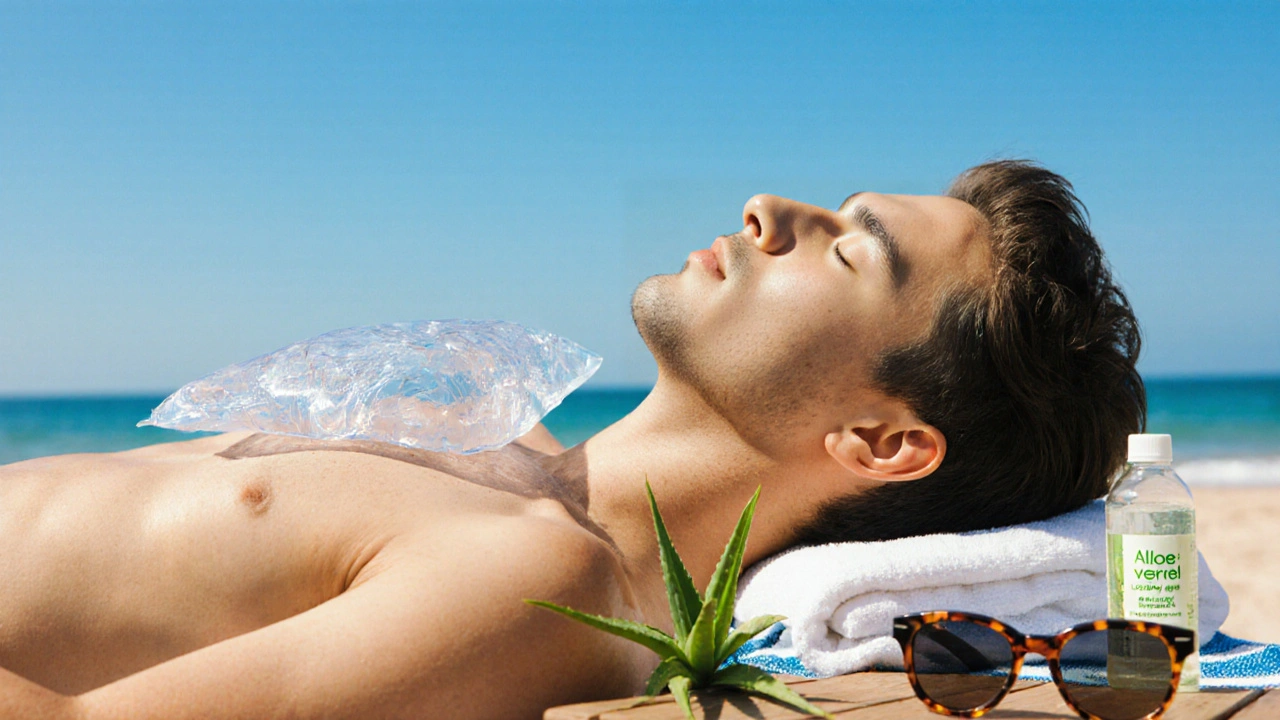Quick Takeaways
- Apply a cold compress within the first hour to limit swelling.
- Use preservative‑free artificial tears every two hours for lubrication.
- Aloe vera gel on the eyelids soothes inflammation without stinging.
- Stay hydrated and avoid further UV exposure with sunglasses.
- Seek medical care if pain worsens, vision blurs, or symptoms last more than 48hours.
Sunburned eye is a condition where excessive ultraviolet (UV) radiation damages the ocular surface and surrounding skin, causing redness, pain, and swelling. It’s more than a cosmetic nuisance; the inflammation can affect vision and increase infection risk. Understanding why the swelling happens and how to intervene early makes all the difference.
Why Does Sun Exposure Cause Eye Swelling?
UV radiation is divided into UVA (320‑400nm) and UVB (280‑320nm). While UVA penetrates deeper into the cornea, UVB burns the outer epithelium. Both trigger a cascade of blood vessel dilation, fluid leakage, and inflammatory mediator release, which manifest as eye swelling sunburn. The eyelid skin, being thin and richly vascularized, reacts quickly, leading to noticeable edema.
Ultraviolet radiation is electromagnetic energy from the sun that can damage DNA, proteins, and cellular membranes in eye tissues. When the eye’s protective tear film is compromised, the cornea and conjunctiva become vulnerable, resulting in a condition known as photokeratitis an acute inflammation of the cornea similar to a sunburn. Photokeratitis often accompanies eyelid edema and can intensify the swelling.
Immediate First‑Aid Steps
- Cool the area: Place a clean, chilled (not icy) compress over closed eyelids for 10‑15minutes. Repeat every hour for the first 4hours. The cold temperature narrows blood vessels, limiting fluid buildup.
- Rinse gently: Flush the eye with sterile isotonic saline or a preservative‑free eyewash to remove any particulate dust that may have settled during sun exposure.
- Hydrate: Drink at least 2liters of water within the next 24hours. Proper systemic hydration supports the body’s natural anti‑inflammatory processes.
Effective Home Remedies
Beyond the cold compress, several soothing agents can accelerate recovery.
Cold Compress vs. Aloe Vera Gel
| Feature | Cold Compress | Aloe Vera Gel |
|---|---|---|
| Mechanism | Vasoconstriction reduces fluid leakage | Anti‑inflammatory polysaccharides soothe skin |
| Onset of Relief | 5‑10minutes | 15‑20minutes |
| Duration of Effect | 30‑45minutes per application | 2‑3hours per thin layer |
| Suitability | All ages, safe for contact lens wearers (after removal) | Best for non‑sensitive skin; avoid direct contact with cornea |
Both methods are safe and inexpensive, but pairing them-cold compress first, followed by a thin aloe layer-offers rapid soothing plus longer‑lasting comfort.
Preservative‑Free Artificial Tears
Artificial tears are sterile solutions that mimic natural tear film, providing lubrication and flushing out irritants. Apply one to three drops every two hours for the first 24hours. This keeps the cornea moist, reduces friction, and helps the inflammatory response settle.
Antihistamine Eye Drops
Although primarily for allergic reactions, antihistamine eye drops block histamine receptors, alleviating itching and swelling can be useful when the sunburned eye feels itchy. Opt for formulations without preservatives to avoid additional irritation.
Over‑the‑Counter Anti‑Inflammatories
Ibuprofen or naproxen taken orally (200‑400mg every 6‑8hours) reduces systemic inflammation, which indirectly lessens eyelid edema. Always follow the label and consider any medical contraindications.
Aloe Vera Gel Application
For the delicate skin around the eyes, use a pure aloe vera extract (no added fragrance). Apply a pea‑size amount to closed lids, leave for 10minutes, then gently wipe away with a cool damp cloth. Aloe’s polysaccharides facilitate tissue repair while its cooling effect mimics a compress.
Medical Interventions When Home Care Isn’t Enough
If swelling persists beyond 48hours, pain intensifies, or visual acuity drops, professional evaluation is essential.
- Corticosteroid eye drops: Prescription drops can dramatically reduce inflammation but require ophthalmologist monitoring.
- Antibiotic ointments: If there’s a risk of secondary bacterial infection (e.g., cracked skin), a topical antibiotic may be prescribed.
- Pain management: Oral analgesics stronger than OTC NSAIDs, such as acetaminophen‑codeine combos, may be used under medical guidance.

Preventing Future Sun‑Related Eye Damage
Prevention is the smartest strategy.
- Sunglasses with 100% UVA/UVB protection: Look for labels indicating “UV400” or “100% UVA/UVB”. Wrap‑around styles minimize peripheral exposure.
- Wide‑brimmed hats: A 3‑inch brim reduces direct UV rays reaching the eyes by up to 50%.
- Indoor breaks: Every 30minutes of outdoor activity, seek shade or step indoors to give eyes a rest.
- Stay hydrated: Adequate fluid intake helps maintain tear film thickness, a natural defense against UV‑induced dryness.
Related Conditions Worth Knowing
Understanding adjacent eye issues helps you recognize when swelling signals something else.
- Conjunctivitis inflammation of the conjunctiva, often caused by infection or allergens, that can mimic sunburn swelling. \n
- Blepharitis chronic eyelid inflammation, which can exacerbate swelling after UV exposure.
When to Seek Professional Help
Make an appointment with an eye‑care professional if you notice any of the following:
- Severe pain that doesn’t improve with OTC pain relievers.
- Blurred or double vision.
- Persistent redness beyond 48hours.
- Fluid or pus discharge from the eye.
- Sensitivity to light (photophobia) that interferes with daily activities.
Summary
Managing eye swelling caused by sunburn hinges on rapid cooling, lubrication, and anti‑inflammatory support. Simple home remedies-cold compress, aloe vera, and preservative‑free artificial tears-often resolve symptoms within a day. Stay vigilant for signs that demand medical attention, and adopt UV‑blocking habits to protect your eyes in future sunny outings.
Frequently Asked Questions
Can I use regular ice packs on my eyes?
No. Direct ice can freeze the delicate skin and even damage the cornea. Use a wrapped cold compress or a bag of frozen peas wrapped in a thin cloth. The goal is cooling, not freezing.
Is it safe to wear contact lenses after a sunburn?
Remove lenses immediately. UV exposure can dry and irritate the cornea, and lenses trap debris. Switch to glasses until the eyes feel comfortable and any swelling subsides.
How long does photokeratitis usually last?
Symptoms typically improve within 24‑48hours with proper care. If pain or vision problems continue beyond 72hours, see an ophthalmologist.
Can over‑the‑counter antihistamine drops replace cold compresses?
They help with itching and mild swelling but don’t address the underlying fluid buildup. Use both: a compress first, then drops if itching persists.
Do sunglasses prevent eyelid swelling?
High‑quality UV400 sunglasses block the radiation that triggers the inflammation, so they significantly reduce the risk of swelling when worn consistently.
Is aloe vera safe for children’s eye swelling?
Yes, as long as the gel is pure, fragrance‑free, and applied only to the eyelid skin-never directly into the eye. Test a small patch first to rule out allergy.


Comments (10)
Andrew Buchanan
27 Sep, 2025Thank you for the thorough overview; the step‑by‑step cold compress instructions are especially useful for anyone dealing with acute eye swelling.
Krishna Chaitanya
27 Sep, 2025Wow the sun really turned my eyes into a volcanic eruption I felt like magma was bubbling behind my lids
diana tutaan
27 Sep, 2025The article overstates aloe’s benefits; without clinical data the claim feels more marketing than medicine.
Sarah Posh
27 Sep, 2025I completely understand how scary it can feel when your eyelids puff up after a long day in the sun.
First, remember that a gentle cold compress is the fastest way to dial down that inflammation.
You don’t need ice; a bag of frozen peas wrapped in a thin towel works perfectly and won’t damage the delicate skin.
While you’re cooling the area, keep a bottle of preservative‑free artificial tears on hand and apply them every couple of hours.
This helps maintain a healthy tear film and flushes out any tiny particles that may have gotten trapped.
Hydration is another cornerstone – aim for at least two liters of water throughout the day to support your body’s natural anti‑inflammatory processes.
If you have pure aloe vera gel, a thin layer on the closed lids can add an extra soothing element after the compress is removed.
Just be sure the gel is fragrance‑free and avoid getting it into the eye itself.
For those who wear contacts, it’s safest to switch to glasses until the swelling subsides, as lenses can trap irritants.
Over‑the‑counter NSAIDs like ibuprofen can help from the inside if the discomfort is more than just superficial.
Should the pain worsen or your vision blur, seeking professional care promptly is the right move.
An ophthalmologist can prescribe a short course of steroid eye drops to bring the swelling down more aggressively.
Meanwhile, wearing UV400 sunglasses whenever you’re outdoors will drastically cut down future episodes.
A wide‑brimmed hat adds another layer of protection, especially during peak sun hours.
By combining these practical steps you’ll likely see a noticeable improvement within a day, and you’ll feel more confident heading back into the sunshine.
James Knight
27 Sep, 2025Seriously, you’re just telling people to cool down and drink water like that’s groundbreaking.
Jonathan Martens
27 Sep, 2025From a photobiology perspective UV‑induced edematous response is basically a cascade of cytokine‑mediated vascular permeability hence the recommendation of vasoconstrictive compresses is scientifically sound albeit obvious.
Chris Fulmer
28 Sep, 2025I’ve tried the pea‑size aloe trick and it really does feel like a mini‑spa for the lids plus the cool compress jump‑starts the relief.
William Pitt
28 Sep, 2025Keep the schedule consistent; apply artificial tears every two hours and you’ll notice the tear film stabilizing which in turn keeps the swelling from escalating.
Jeff Hershberger
28 Sep, 2025The swelling is like a tiny balloon inflating on the eyelid, and the cold compress acts as a gentle deflator.
Jesse Najarro
28 Sep, 2025Pairing the compress with a short course of oral ibuprofen can address both surface inflammation and deeper tissue swelling for faster recovery.